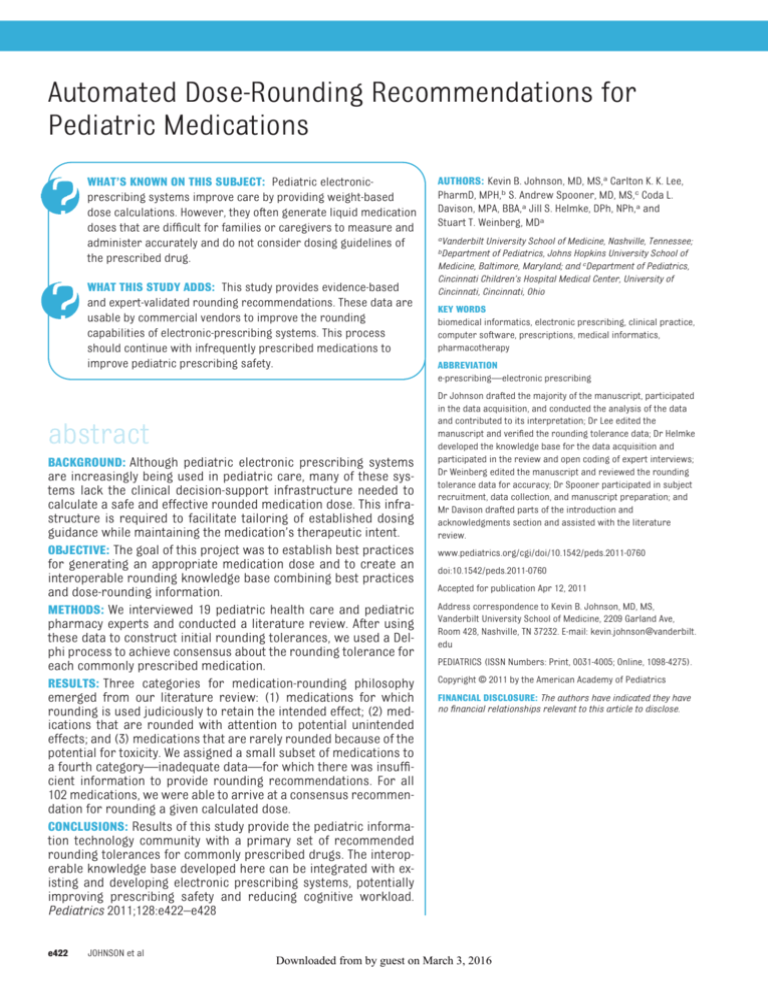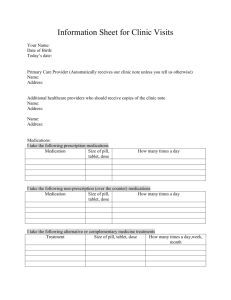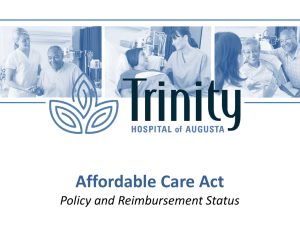
Automated Dose-Rounding Recommendations for
Pediatric Medications
WHAT’S KNOWN ON THIS SUBJECT: Pediatric electronicprescribing systems improve care by providing weight-based
dose calculations. However, they often generate liquid medication
doses that are difficult for families or caregivers to measure and
administer accurately and do not consider dosing guidelines of
the prescribed drug.
WHAT THIS STUDY ADDS: This study provides evidence-based
and expert-validated rounding recommendations. These data are
usable by commercial vendors to improve the rounding
capabilities of electronic-prescribing systems. This process
should continue with infrequently prescribed medications to
improve pediatric prescribing safety.
abstract
BACKGROUND: Although pediatric electronic prescribing systems
are increasingly being used in pediatric care, many of these systems lack the clinical decision-support infrastructure needed to
calculate a safe and effective rounded medication dose. This infrastructure is required to facilitate tailoring of established dosing
guidance while maintaining the medication’s therapeutic intent.
OBJECTIVE: The goal of this project was to establish best practices
for generating an appropriate medication dose and to create an
interoperable rounding knowledge base combining best practices
and dose-rounding information.
METHODS: We interviewed 19 pediatric health care and pediatric
pharmacy experts and conducted a literature review. After using
these data to construct initial rounding tolerances, we used a Delphi process to achieve consensus about the rounding tolerance for
each commonly prescribed medication.
RESULTS: Three categories for medication-rounding philosophy
emerged from our literature review: (1) medications for which
rounding is used judiciously to retain the intended effect; (2) medications that are rounded with attention to potential unintended
effects; and (3) medications that are rarely rounded because of the
potential for toxicity. We assigned a small subset of medications to
a fourth category—inadequate data—for which there was insufficient information to provide rounding recommendations. For all
102 medications, we were able to arrive at a consensus recommendation for rounding a given calculated dose.
CONCLUSIONS: Results of this study provide the pediatric information technology community with a primary set of recommended
rounding tolerances for commonly prescribed drugs. The interoperable knowledge base developed here can be integrated with existing and developing electronic prescribing systems, potentially
improving prescribing safety and reducing cognitive workload.
Pediatrics 2011;128:e422–e428
e422
JOHNSON et al
AUTHORS: Kevin B. Johnson, MD, MS,a Carlton K. K. Lee,
PharmD, MPH,b S. Andrew Spooner, MD, MS,c Coda L.
Davison, MPA, BBA,a Jill S. Helmke, DPh, NPh,a and
Stuart T. Weinberg, MDa
a
Vanderbilt University School of Medicine, Nashville, Tennessee;
Department of Pediatrics, Johns Hopkins University School of
Medicine, Baltimore, Maryland; and cDepartment of Pediatrics,
Cincinnati Children’s Hospital Medical Center, University of
Cincinnati, Cincinnati, Ohio
b
KEY WORDS
biomedical informatics, electronic prescribing, clinical practice,
computer software, prescriptions, medical informatics,
pharmacotherapy
ABBREVIATION
e-prescribing—electronic prescribing
Dr Johnson drafted the majority of the manuscript, participated
in the data acquisition, and conducted the analysis of the data
and contributed to its interpretation; Dr Lee edited the
manuscript and verified the rounding tolerance data; Dr Helmke
developed the knowledge base for the data acquisition and
participated in the review and open coding of expert interviews;
Dr Weinberg edited the manuscript and reviewed the rounding
tolerance data for accuracy; Dr Spooner participated in subject
recruitment, data collection, and manuscript preparation; and
Mr Davison drafted parts of the introduction and
acknowledgments section and assisted with the literature
review.
www.pediatrics.org/cgi/doi/10.1542/peds.2011-0760
doi:10.1542/peds.2011-0760
Accepted for publication Apr 12, 2011
Address correspondence to Kevin B. Johnson, MD, MS,
Vanderbilt University School of Medicine, 2209 Garland Ave,
Room 428, Nashville, TN 37232. E-mail: kevin.johnson@vanderbilt.
edu
PEDIATRICS (ISSN Numbers: Print, 0031-4005; Online, 1098-4275).
Copyright © 2011 by the American Academy of Pediatrics
FINANCIAL DISCLOSURE: The authors have indicated they have
no financial relationships relevant to this article to disclose.
Downloaded from by guest on March 3, 2016
ARTICLES
Pediatric prescribing is a complicated
process that requires the prescriber
to calculate a medication dose that is
appropriate for the treatment goals
and for the child’s weight or body surface area.1 Although some medications
are relatively tolerant of inaccurate
dosing, others that have narrow
therapeutic indices, such as digoxin
or insulin, have a great potential for
adverse consequences if dosed improperly.2–4 This process is sufficiently
complicated that most pediatricians
rely on prescribing guides in print or
electronic form to practice safely.5,6
Emerging therapies with less wellpublished dosing guidelines also make
safe and effective pediatric prescribing difficult.5,7
Electronic prescribing (e-prescribing)
has become a national initiative supported by the Centers for Medicare &
Medicaid Services, the Institute of
Medicine, the American Academy of Pediatrics, and other professional societies and organizations. In part, this support has been facilitated by mounting
evidence about prescribing errors
that have been well summarized8–10
and that promise to improve the rate
of medication errors in pediatrics.1,11,12
There are less data to support the use
of e-prescribing in the ambulatory pediatric community,13 despite the challenges associated with pediatric patient medication management.14 A
study by Kaushal et al15 noted the potential for e-prescribing to prevent up
to 21% of adverse drug events in outpatient settings, including those related to drug frequency and weight/
dose checks. Most e-prescribing
systems do not generate easily administered (rounded) doses. Therefore,
these systems often require clinicians
to edit the computed dose, increasing
the risk of introducing dosing errors.16
In addition, there is no validated resource containing knowledge about
the appropriate rounding tolerances
PEDIATRICS Volume 128, Number 2, August 2011
for different pediatric medications.
There also is no established approach
for generating a rounded dose that
is easily administered by patients;
therefore, it is difficult for e-prescribing
systems to adopt a rounding algorithm
with the currently available knowledge.
The goal of this project was to establish
best practices for generating an appropriate medication dose and to create an
interoperable rounding knowledge base
combining best practices and doserounding information.
a project Wiki site (www.dokuwiki.org)
with restricted access for review and
discussion among project team members. An iterative process based on
discussion and revision of rounding
techniques was used to focus and refine subsequent interviews. Results
from the interviews were used to help
define practical approaches to rounding and to develop a framework for
categorizing medications according to
the usual rounding philosophy as described by our experts.
METHODS
Literature Review
To address the project goals, we relied
on information from interviews and a
literature review. We also used a
consensus-based process to validate
proposed rounding tolerances.
We reviewed pharmacologic information for 120 medications that comprised ⬎95% of the most commonly
prescribed pediatric medications in 2
academic medical centers.17 We collected weight-based dosing guidelines,
minimum and maximum dosing
amounts, and drug toxicity or adverse
effect information from a series of
commonly cited articles and texts.18–20
We also consulted the gray literature,
including Web resources and the US
Food and Drug Administration Web
site, for information about some
medications. Using the framework
developed in the interview phase, we
evaluated dosing knowledge for each
medication and assigned it to a category within this framework. We
used the properties of the assigned
rounding category, along with dosing information from domain experts
and information about the drug’s
therapeutic intent and potential adverse reactions obtained from the literature review, to propose an initial
rounding percentage.
Interviews
We conducted semi-structured interviews to assess the overall considerations used in rounding prescribed
medications. We used a purposive
sampling plan to recruit subjects who
included local and national experts in
general pediatrics, subspecialty pediatrics, pediatric pharmacy, biomedical
informatics, and pharmacology. The
sampling plan focused primarily on ambulatory locations, where medication
dosing takes into account the needs of
home caregivers who must measure
and administer the medication.
A member of the project team provided a brief project overview to each
domain expert before the interview.
Each interview started with a recapitulation of the project goals, and then focused the interview around 3 framing
questions: “Please describe how you
create a prescription where the effects, both intentional and unintentional, are related to the dose”; “Please
describe the process for prescribing a
compound medication“; and “What is
your process for rounding?” All interviews were transcribed and posted to
Downloaded from by guest on March 3, 2016
Rounding Percentage Validation
We used a Delphi approach aimed at
generating consensus about each
rounding recommendation. This technique works well “to correlate informed judgments on a topic spanning
a wide range of disciplines.”21 In our
project, this model for consensus
e423
TABLE 1 Rounding Survey Sample Question
Pretend you have a patient who is being prescribed a dose of each medication below. You have calculated this dose using standard milligram per kilogram per
day formulae and arrive at 5.82 mL/dose, and there is only 1 formulation to choose from. The e-prescribing system you use returns a rounded dose,
based on ease of home administration.
If the medication allows 0% rounding, the dose will be 5.8 mL.
If the medication allows 1% rounding, the dose will be between 5.7 and 5.9 mL. You would likely pick 5.9 mL.
If the medication allows 5% rounding, the dose will be between 5.5 and 5.9 mL. You would likely pick 5.9 mL.
If the medication allows 10% rounding, the dose will be between 5.2 and 6.4 mL. You would likely pick 6 mL.
If the medication allows 15% rounding, the dose will be between 4.9 and 6.7 mL. You would likely pick 6 mL.
Give these choices, for each drug below, do you agree or disagree with the maximum amount we would suggest to allow rounding?
Digoxin. Do not round further; okay?
Must provide value
Calcitriol. Do not round further; okay?
Must provide value
Ondansetron (Zofran). Do not round further; okay?
Must provide value
Morphine. Do not round further; okay?
Must provide value
Tylenol with codeine, round by 5%; okay?
Must provide value
Clarithromycin (Biaxin), round by 5%; okay?
Must provide value
Diphenhydramine, round by 5%; okay?
Must provide value
Griseofulvin, round by 10%; okay?
Must provide value
Penicillin, round by 15%; okay?
Must provide value
Guaifenesin/dextromethorphan, round by 15%; okay?
Must provide value
building was ideal for a primarily online group of pharmacists, primary
care providers, and hospitalists to discuss the degree to which medications
should be rounded automatically.
We began by entering proposed rounding percentages into an electronic survey instrument familiar to the expert
reviewers called REDCap.22 Each question presented the recommended
rounding percentage and allowed
each group member to agree or disagree with the recommendation. A
sample question is shown in Table 1.
Each expert completed the survey
anonymously. After experts completed
the first round of surveys, a facilitator
(Dr Johnson or Dr Helmke) tabulated
all responses and provided feedback
to the expert group as a whole. All medications for which there was ⬍80%
consensus about the proposed rounding percentage were discussed among
the participants. On the basis of this
discussion, we modified the rounding
e424
JOHNSON et al
percentages for these medications,
and completed a second round of the
survey. We included 2 pediatric neurologists later in this process to review
and agree on rounding tolerances for
sets of medications typically prescribed by members of that specialty.
Finally, there were 16 medications that
the group unanimously agreed were
out of scope for this effort, either because the group was unfamiliar with
their use (eg, ziprasidone) or because
it was determined that dosing in pediatric offices typically did not use existing weight-based guidelines (eg, ursodiol). Group consensus for all other
medications was achieved after 4
rounds of discussion.
RESULTS
Rounding Framework Development
Table 2 describes the experience and
the roles played by each member of
the advisory group. Some members
Downloaded from by guest on March 3, 2016
participated in interviews or rounding
knowledge validation, or both, as designated below.
On the basis of these interviews,
we discovered that domain experts
approach medication dosing and
rounding by balancing the goals of
therapy with the potential for adverse effects related to dosing. Three
philosophical approaches emerged.
We also created an additional category for medications with insufficient data available to assess the
risk of automated rounding.
Dose-Dependent Intended Effects
The first approach was relevant when
the intended effect was itself dose dependent. The iconic active ingredient
for this approach was furosemide,
which produces diuresis in rough proportion to the amount of the medication given per dose. In this case, domain experts typically start low and
titrate the drug upward, typically in
ARTICLES
TABLE 2 Expert Working Group Specialties and Activities
On the basis of conversations with domain
experts, we assigned tolerable rounding
ranges to each category above. These data
are listed in Table 3.
In most cases, expert review resulted
in a widening, rather than a narrowing, of the rounding tolerance. For
example, despite the risk of dosedependent tardive dyskinesia associated with using metoclopramide, in
practice this drug is often rounded
more aggressively. Therefore, the
rounding percentage was increased
from 5% as initially proposed to 10%.
We achieved unanimous consensus for
39% of the proposed medicationrounding tolerances in the first round
of voting. There were medications that
the group agreed were rarely used in
practice and were therefore out of
scope for this initial project. These
drugs included antiretroviral medications (ritonavir, oseltamivir, and lamivudine) and some rarely used neurologic medications. After discussion at
a face-to-face meeting, 2 subsequent
rounds resulted in all but 7
medication-rounding percentages being acceptable to the group. This final
group of medications, typically started
by pediatric neurologists, required extensive discussion between the expert
group and 2 guest neurologists before
consensus was reached.
Table 4 lists the medications, rounding
categories, and rounding percentages
for each of the 120 medications in
our database along with degree of
agreement among all members of
the advisory group. Medications
such as amitryptyline and digoxin
were sufficiently toxic that our team
recommended rounding down to the
nearest one-tenth of a milliliter.
DISCUSSION
Using information obtained from pediatricians, pharmacists, and an extensive literature review, we proposed and
validated a set of rounding ranges and
then assigned each medication to a
rounding category. These data form an
important body of knowledge that can be
used by e-prescribing systems to automatically calculate administrable and
Pediatric Specialty
Total
Participants,
n
Median Time in
Specialty, y
Interviewed,
n
Validated Knowledge
(Delphi Process), n
Generalist
Hospitalist
Cardiologist
Nephrologist
Pharmacist (PharmD)
Hematology
Neurologista
7
2
1
1
5
1
2
25
13
24
22
22
8
15
4
2
1
1
3
1
0
6
1
1
0
3
0
2
a
Involved in second and third rounds of consensus.
small (10%) increments. Medications
in this group may be automatically
rounded up or down in increments
smaller than 10% to reach a more easily administered dose with the same
intended effect.
Dose-Dependent Unintended Effects
The second approach had as a goal
avoiding unintentional adverse effects.
This approach is typically used for
medications such as antibiotics or
systemic steroids, in which dosedependent adverse effects may be
avoided by lowering the dose. For most
medications in this group, dosing
tends to begin at the highest welltolerated dosage for the indication,
and then rounded down to an easily
administered dose, bearing in mind
the maximum dosing recommendation
guidelines.
Narrow Therapeutic Range
The third approach recognized the
potential for drugs to have a narrow
therapeutic index and a high risk for
toxicity. Drugs such as digoxin and
insulin are in this category and typically are not rounded, or are
rounded to the nearest one-tenth of a
milliliter from the originally calculated dose.
a slight overdose based on adult
data. In these cases, no rounding is
typically performed. For many of
these medications, there is no
manufactured liquid formulation,
further complicating the automated
process by requiring the pharmacist
to construct a compounded form of
the medication. Because the final formulation may not be known, it is
not possible to create an easyto-administer dose during the
e-prescribing process.
Recommendations for Rounding
TABLE 3 Summary of Rounding Tolerance Categories
Category
Unintended Adverse
Effects Dependent
on Dose
Impact of Effect
Dependent
on Dose
Avoiding unintentional
adverse effects
Controlling intended effects
Avoiding toxicity
Insufficient data
Yes
No
No
No
No
NA
Yes
No
NA
No
Yes
Usually
Insufficient Data Available
We included a fourth category for
medications, such as mesalamine, in
which insufficient data exist about
the proper dosing model for children, and toxicity is likely with even
PEDIATRICS Volume 128, Number 2, August 2011
Narrow
Therapeutic
Index
Rounding
Tolerance,
%
10–15
5–10
1–5
0–1
NA indicates not available.
Downloaded from by guest on March 3, 2016
e425
safe doses for young children. Moreover,
by using an iterative consensus process,
we obtained a high level of agreement
across 99.3% of all medications.
Our validation process was limited in
power by the relatively small number
of pediatricians and pharmacies in our
advisory group; however, the high level
of agreement among pediatricians
with an average of 20 years of experience suggests that our set of recommendations can serve as the critical
first step to establishing a comprehensive knowledge base. Additional studies should evaluate the extent to which
these recommendations are accepted
or overridden by pediatric prescribers, as well as the incidence of adverse
events that may arise related to rounding. We also were only able to create
rounding tolerances for a subset of
medications that are commonly prescribed. This process should be continued to address other medications prescribed using weight or body surface
area to derive a dose. In addition, it will
be important to reconvene an expert
group to evaluate new medications
that reach the consumer market. We
estimate that this process would need
to be done at least every 3 years, to
address the ⬃12 new medications
that are added to the Harriet Lane
Handbook every edition (C. K. K. L., unpublished data, 2011).
As noted here, this project is the first
attempt at creating a knowledge base
of pediatric rounding tolerances that
can be incorporated into any
e-prescribing system whose vendor
has an interest in using this knowledge. However, this work is only the
beginning of developing tools required to create a safe pediatric
e-prescribing environment. In part, the
challenge to this task is the lack of evidence supporting common dosing standards, such as those published in typical
pediatric textbooks. However, even these
“eminence-based” recommendations do
e426
JOHNSON et al
TABLE 4 Summary of Medication-Rounding Tolerances
Medication (Rounding
Tolerance)
Category
Consensus
Round
Amitriptyline (0%)
Acetaminophen (10%)
Amlodipine (10%)
Amoxicillin/clavulanic acid (15%)
Amoxicillin (15%)
APAP/codeine (5%)
Aspirin (10%)
Atenolol (5%)
Methotrexate (0%)
Azathioprine (5%)
Azithromycin (15%)
Budesonide (10%)
Carbamazepine (2%)
Cefdinir (10%)
Cefixime (10%)
Cefuroxime (10%)
Cephalexin (15%)
Chlorothiazide (10%)
Cimetidine (10%)
Ciprofloxacin (1%)
Clarithromycin (10%)
Clindamycin (10%)
Clonazepam (0%)
Clonidine (0%)
Cyproheptadine (5%)
Dexamethasone (5%)
Dextroamphetamine (10%)
Diazepam (2%)
Digoxin (0%)
Diphenhydramine (10%)
Docusate sodium (10%)
Doxycycline (10%)
Enalapril maleate (10%)
Erythromycin (10%)
Ethosuximide (2%)
Famotidine (15%)
Felbamate (0%)
Fluconazole (10%)
Fluoxetine (5%)
Folic acid (10%)
Furosemide (5%)
Gabapentin (10%)
Glycopyrrolate (5%)
Griseofulvin (10%)
Guaifenesin (15%)
Hydrocodone/APAP (5%)
Hydroxychloroquine (0%)
Hydroxyzine (10%)
Ibuprofen (15%)
Iron supplements (10%)
Ketoconazole (10%)
Lamotrigine (10%)
Levetiracetam (2%)
Levofloxacin (1%)
Levothyroxine (0%)
Lithium (0%)
Lorazepam (2%)
Mercaptopurine (0%)
Mesalamine (0%)
Methadone (0%)
Methimazole (5%)
Methylprednisolone (10%)
Unintended effects
Toxicity
Unintended effects
Unintended effects
Unintended effects
Unintended effects
Unintended effects
Excess intended effect
Toxicity
Unintended effects
Unintended effects
Unintended effects
Unintended effects
Unintended effects
Unintended effects
Unintended effects
Unintended effects
Excess intended effect
Unintended effects
Unintended effects
Unintended effects
Unintended effects
Toxicity
Toxicity
Unintended effects
Unintended effects
Unintended effects
Toxicity
Toxicity
Excess intended effect
Unintended effects
Unintended effects
Unintended effects
Unintended effects
Toxicity
Unintended effects
Unintended effects
Unintended effects
Unintended effects
Unintended effects
Excess intended effect
Unintended effects
Unintended effects
Unintended effects
Unintended effects
Unintended effects
Toxicity
Unintended effects
Unintended effects
Unintended effects
Unintended effects
Unintended effects
Toxicity
Unintended effects
Toxicity
Toxicity
Toxicity
Toxicity
Insufficient evidence
Toxicity
Unintended effects
Unintended effects
2
1
1
1
1
3
1
2
1
2
2
1
4
1
1
1
1
1
1
2
2
2
4
2
3
2
1
4
2
3
2
2
1
2
3
1
3
1
3
1
2
1
3
2
1
3
2
1
1
3
1
1
2
2
2
3
3
2
4
2
1
1
Downloaded from by guest on March 3, 2016
ARTICLES
TABLE 4 Continued
Medication (Rounding
Tolerance)
Metoclopramide (10%)
Metronidazole (5%)
Minocycline (10%)
Morphine (0%)
Moxifloxacin (1%)
Mycophenolate (5%)
Naproxen (10%)
Nortriptyline (0%)
Omeprazole (10%)
Ondansetron (10%)
Oxcarbazapine (5%)
Oxycodone (5%)
Oxycodone/APAP (5%)
Pancreatin (15%)
Pancrelipase (15%)
PEG (15%)
Penicillin V (15%)
Permethrin (15%)
Phenobarbital (2%)
Pimozide (15%)
Prednisolone (10%)
Prednisone (10%)
Pregabalin (2%)
Propranolol (5%)
Pyridoxine (15%)
Ranitidine (15%)
Risperidone (5%)
Rizatriptan (5%)
Sertraline (15%)
Spironolactone (10%)
Sucralfate (15%)
Sumatriptan (5%)
Tizanidine (5%)
Topiramate (2%)
Trazodone (15%)
Trimethoprim/SMX (10%)
Valproic acid (2%)
Warfarin (0%)
Zolmitriptan (15%)
Zonisamide (2%)
Category
Consensus
Round
Unintended effects
Unintended effects
Unintended effects
Toxicity
Unintended effects
Unintended effects
Unintended effects
Insufficient evidence
Unintended effects
Unintended effects
Unintended effects
Unintended effects
Unintended effects
Unintended effects
Unintended effects
Unintended effects
Unintended effects
Unintended effects
Toxicity
Unintended effects
Unintended effects
Unintended effects
Unintended effects
Excess intended effect
Unintended effects
Unintended effects
Toxicity
Toxicity
Unintended effects
Excess intended effect
Unintended effects
Toxicity
Toxicity
Excess intended effect
Excess intended effect
Unintended effects
Toxicity
Toxicity
Excess intended effect
Unintended effects
1
2
1
2
2
1
1
2
2
2
4
2
2
3
3
3
2
3
4
4
1
1
3
2
1
1
3
3
3
1
1
1
3
4
4
2
4
1
1
4
Category refers to the general dosing philosophy used by practitioners for this medication; consensus round refers to the
number of times this medication was discussed before consensus was achieved. APAP indicates acetaminophen; PEG,
polyethylene glycol; SMX, sulfamethoxazole.
not exist in a computable form. In an era
in which there are mandates and incentives for adopting e-prescribing systems,
this deficit is likely to negatively impact
the otherwise highly usable systems recommended by regional extension centers or certifying bodies. Our study provides an initial expert-developed set of
recommendations that can be readily incorporated into an evolving pediatric
e-prescribing milieu. It is our hope that
these recommendations will provide a
PEDIATRICS Volume 128, Number 2, August 2011
starting point for all vendors to improve
their automated processes.
It is also important to recognize the
challenges of home medication administration, as noted by Kaushal et al,15
when creating a medication dose.
These recommendations will need to
be combined with models that facilitate the cognitive processes associated with selecting an appropriate
formulation, taking into account vari-
Downloaded from by guest on March 3, 2016
ables such as the patient’s age, the
presence of a feeding tube, patient
preferences for volume of medication,
and other considerations.
ACKNOWLEDGMENTS
This research project was funded by
the Agency for Healthcare Research
and Quality under grant R18HS17216.
We thank the agency for their support and thoughtful comments
throughout this project, and we
thank the members of the STEPSTools Working Advisory Group. They
all played a key role in the development of the Web service tool, and
their contributions to this article are
greatly appreciated.
The following are members of the
STEPSTools Working Advisory Group:
John Canning, Physician’s Computer
Company; Coda L. Davison, MPA, BBA,
Vanderbilt University School of Medicine; Cynthia S. Gadd, PhD, MBA, Vanderbilt University School of Medicine;
Robert Grundmeier, MD, Children’s
Hospital of Philadelphia; Chip Hart,
Physician’s Computer Company; Jill S.
Helmke, DPh, NPh, Vanderbilt University School of Medicine; Yun-Xian Ho,
PhD, Vanderbilt University School of
Medicine; Carlton K. K. Lee, PharmD,
MPH, The Johns Hopkins University
School of Medicine; Jennifer Mansour,
MSW, CPHIT, CPEHR, American Academy of Pediatrics; Eugenia Marcus,
MD, Pediatric Health Care; Beki Marshall, CPHIT, CPEHR, American Academy of Pediatrics; Jerome A. Osheroff,
MD, Thomas Reuters; Marvin Palmer,
Vanderbilt University School of Medicine; Mark M. Simonian, MD, American
Academy of Pediatrics Liaison; S. Andrew Spooner, MD, MS, Cincinnati Children’s Hospital; and Stuart T. Weinberg, MD, Vanderbilt University School
of Medicine.
e427
REFERENCES
1. Sullivan JE, Buchino JJ. Medication errors
in pediatrics: the octopus evading defeat. J
Surg Oncol. 2004;88:182–188
2. Lesar TS. Errors in the use of medication
dosage equations. Arch Pediatr Adolesc
Med. 1998;152(4):340 –344
3. Lesar TS, Briceland LL, Delcoure K, Parmalee JC, Masta-Gornic V, Pohl H. Medication prescribing errors in a teaching hospital. JAMA. 1990;263(17):2329 –2334
4. Rowe C, Koren T, Koren G. Errors by paediatric residents in calculating drug doses.
Arch Dis Child. 1998;79(1):56 –58
5. Kim GR, Bartlett EL Jr, Lehmann HP. Information resource preferences by general pediatricians in office settings: a qualitative
study. BMC Med Inform Decis Mak. 2005;
5:34
6. Khan AN, Frank J, Geria R, Davidson S. Utilization of personal digital assistants (PDAS)
by pediatric and emergency medicine residents. J Emerg Med. 2007;32(4):423– 428
7. D’Alessandro DM, Kreiter CD, Peterson MW,
Kingsley P, Johnson-West J. An analysis of
patient care questions asked by pediatricians at an academic medical center. Ambul Pediatr. 2004;4(1):18 –23
8. Aspden P, Corrigan JM, Wolcott J, Erickson
SM, eds. Institute of Medicine. Patient
Safety: Achieving a New Standard for Care.
Committee on Data Standards for Patient
Safety. Washington, DC: National Academies
Press; 2004
9. Fortescue EB, Kaushal R, Landrigan CP, et al.
e428
JOHNSON et al
10.
11.
12.
13.
14.
15.
Prioritizing strategies for preventing medication errors and adverse drug events in
pediatric inpatients. Pediatrics. 2003;111(4
pt 1):722–729
Aspden P, Wolcott JA, Bootman JL, Cronenwett LR, eds. Institute of Medicine, Committee on Identifying and Preventing Medication Errors. Preventing Medication Errors.
Washington, DC: National Academies Press;
2007
Kaushal R, Barker KN, Bates DW. How can
information technology improve patient
safety and reduce medication errors in children’s health care? Arch Pediatr Adolesc
Med. 2001;155(9):1002–1007
Potts AL, Barr FE, Gregory DF, Wright L, Patel
NR. Computerized physician order entry
and medication errors in a pediatric critical
care unit. Pediatrics. 2004;113(1 pt 1):
59 – 63
American Academy of Pediatrics Committee
on Clinical Information Technology, Gerstle
RS. Electronic prescribing systems in
pediatrics: the rationale and functionality
requirements. Pediatrics. 2007;119(6):
1229 –1231
Levine SR, Cohen MR, Blanchard NR, et al.
Guidelines for preventing medication errors in pediatrics. J Ped Pharmacol Ther.
2001;6:426 – 442
Kaushal R, Goldmann DA, Keohane CA, et
al. Adverse drug events in pediatric outpatients. Ambul Pediatr. 2007;7(5):
383–389
Downloaded from by guest on March 3, 2016
16. Killelea BK, Kaushal R, Cooper M, Kuperman
GJ. To what extent do pediatricians accept
computer-based dosing suggestions? Pediatrics. 2007;119(1). Available at: www.
pediatrics.org/cgi/content/full/119/1/e69
17. Johnson KB, Weissenberger S, Lee CK,
Walker A, Serwint JR. Myth Versus Reality:
What and How Do General Pediatricians Prescribe? Paper presented at: 2007 Pediatric
Academic Societies’ Annual Meeting; May
5– 8, 2007; Toronto, Ontario, Canada
18. Custer JW, Rau RE, eds. The Harriet Lane
Handbook : A Manual for Pediatric House
Officers. 18th ed. Philadelphia, PA: Mosby/
Elsevier; 2009
19. Lexi-Comp, Inc, American Pharmaceutical
Association. Drug Information Handbook.
Hudson, OH/Washington, DC: American
Pharmaceutical Association; 2003
20. Katzung BG. Basic and Clinical Pharmacology. 9th ed. New York, NY: Lange Medical
Books/McGraw Hill; 2004
21. Delbecq AL, van de Ven AH, Gustafson DH.
Group Techniques for Program Planning: A
Guide to Nominal Group and Delphi Processes. Glenview, IL: Scott Foresman; 1975
22. Harris PA, Taylor R, Thielke R, Payne J,
Gonzalez N, Conde JG. Research electronic
data capture (REDCap): a metadatadriven methodology and workflow process for providing translational research
informatics support. J Biomed Inform.
2009;42(2):377–381
Automated Dose-Rounding Recommendations for Pediatric Medications
Kevin B. Johnson, Carlton K. K. Lee, S. Andrew Spooner, Coda L. Davison, Jill S.
Helmke and Stuart T. Weinberg
Pediatrics 2011;128;e422; originally published online July 25, 2011;
DOI: 10.1542/peds.2011-0760
Updated Information &
Services
including high resolution figures, can be found at:
/content/128/2/e422.full.html
References
This article cites 14 articles, 4 of which can be accessed free
at:
/content/128/2/e422.full.html#ref-list-1
Citations
This article has been cited by 7 HighWire-hosted articles:
/content/128/2/e422.full.html#related-urls
Subspecialty Collections
This article, along with others on similar topics, appears in
the following collection(s):
Health Information Technology
/cgi/collection/health_information_technology_sub
Permissions & Licensing
Information about reproducing this article in parts (figures,
tables) or in its entirety can be found online at:
/site/misc/Permissions.xhtml
Reprints
Information about ordering reprints can be found online:
/site/misc/reprints.xhtml
PEDIATRICS is the official journal of the American Academy of Pediatrics. A monthly
publication, it has been published continuously since 1948. PEDIATRICS is owned, published,
and trademarked by the American Academy of Pediatrics, 141 Northwest Point Boulevard, Elk
Grove Village, Illinois, 60007. Copyright © 2011 by the American Academy of Pediatrics. All
rights reserved. Print ISSN: 0031-4005. Online ISSN: 1098-4275.
Downloaded from by guest on March 3, 2016
Automated Dose-Rounding Recommendations for Pediatric Medications
Kevin B. Johnson, Carlton K. K. Lee, S. Andrew Spooner, Coda L. Davison, Jill S.
Helmke and Stuart T. Weinberg
Pediatrics 2011;128;e422; originally published online July 25, 2011;
DOI: 10.1542/peds.2011-0760
The online version of this article, along with updated information and services, is
located on the World Wide Web at:
/content/128/2/e422.full.html
PEDIATRICS is the official journal of the American Academy of Pediatrics. A monthly
publication, it has been published continuously since 1948. PEDIATRICS is owned,
published, and trademarked by the American Academy of Pediatrics, 141 Northwest Point
Boulevard, Elk Grove Village, Illinois, 60007. Copyright © 2011 by the American Academy
of Pediatrics. All rights reserved. Print ISSN: 0031-4005. Online ISSN: 1098-4275.
Downloaded from by guest on March 3, 2016










